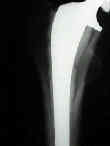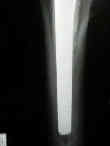- See: Total Hip Replacement Menu:
- Cemented Femoral Component: Loosening:
- Collar: in THR
- Optimal Cementing Technique
- Removal of Cemented Femoral Stems:
- Indications:
- cemented femoral stems probably remain gold standard for total hip arthroplasty;
- most indicated in older patients (more than 65 yrs), but are also used in younger patients since there is some indications that cemented stems
are less prone to develop osteolysis;
- useful for patients w/ "stove pipe" type femur, previous fracture, or previous osteotomy since these patients would not be expected to achieve
a tight fit which is necessary for ingrowth;
- may be indicated poor bone quality such as RA, osteoporosis, or Paget's disease;
- Harrington MA, et al, the authors determined that in a stair-climbing test model, the peak proximal cement strains were increased more by changes in
body wt than they were by changes in neck length. Even during stair-climbing, calcar-collar contact reduced peak cement strains;
- peak strain magnitudes in proximal cement mantle were increased more by changes in body wt than by changes in length of neck of stem;
- strong effect of stem size on the cement strains suggests that cemented femoral stems should not be used in heavy
patients with small medullary canals that require a small cemented stem;
- references
- Cemented femoral fixation: a historical footnote.
- Effects of femoral neck length, stem size, and body weight on strains in the proximal cement mantle.
- outcomes:
- in the study by Callaghan JJ, et al (2000) the authors followed Charnley Total Hip Arthroplasty
patients (with cement) with a minimum 25 year follow up;
- of the 327 hips for which the outcome was known after a minimum of 25 years, 295 (90 %) had retained the original implants until
the patient died or until the most recent follow-up examination;
- of the 62 hips in patients who lived for at least 25 years after the surgery, 48 (77 %) had retained the original prosthesis;
- Charnley total hip arthroplasty with cement. Minimum twenty-five-year follow-up.
- Cemented Component Design:
- prosthesis should have relatively smooth surfaces, w/ no sharp edges, so that sites of stress concentration are eliminated from both prosthesis and cement;
- a prosthesis that is broader laterally than medially may help to diffuse the compressive stress medially;
- tapered shape from proximal to distal allows controlled subsidence within the cement column;
- cobalt-chromium alloy stems are used in most stems, since they generate less particulate debris than titanium implants;
- triple taper concept: femoral component tapers to a point in both the AP and lateral planes and in addition, the stem is more narrow medially and widens laterally;
- references:
- Survivorship analysis of cemented high modulus total hip arthroplasty.
- Effects of Femoral Neck Length, Stem Size, and Body Weight on Strains in the Proximal Cement Mantle
- The design features of cemented femoral hip implants.
- Analysis of 16 retrieved proximally cemented femoral stems.
- Component Surface:
- there is controversy about how much bonding should occur between the cement and the femoral stem;
- excessive bonding between the cement and stem may transfer wt bearing stress to the bone-cement interface, leading to loosening;
- in contrast, excessive motion between the cement-metal interface, may lead to excessive osteolysis and rapid loosening;
- definitions:
- polished: (Ra less than 1 micrometer) polished stems create little abrasion;
- matte: (Ra less than 2 micrometer) matte finnish will not create excessive abrasion unless stem allows large micomotion;
- rough: (Ra greater than 2 micrometer) expected to cause excessive abrasion;
- some are proponents of smooth surface, which may allow subsidence and thereby keeps the cement in compressive loading;
- many components have a matt finish, which allows some mechanical interlock with the cement;
- in the study by Howie DW, et al (1998), 4/20 matt coated stems had been revised for aseptic loosening whereas
0/20 polished stems had been revised (9 year minimum follow up);
- in the study by Collis and Mohler, the authors evaulated loosening in grit blasted versus polished stems;
- study included 244 consecutive total hip arthroplasties with a cemented femoral component performed by one surgeon;
- 4 hips treated with the grit-blasted stem had aseptic loosening with substantial surrounding lysis and required revision;
- an additional two hips in this group had radiographic evidence of substantial lysis and were judged to have an impending need for revision;
- no hip treated with the polished stem required revision, and only one had minimal lysis;
- this difference regarding failures and impending failures was significant (p = 0.05);
- references:
- Loosening of matt and polished cemented femoral stems.
- Comparison of Clinical Outcomes in Total Hip Arthroplasty Using Rough and Polished Cemented Stems with Essentially the Same Geometry
- The skeletal response to matt and polished cemented femoral stems.
- Effects of design changes on cemented tapered femoral stem fixation.
- Early loosening of the femoral component at the cement-prosthesis interface after total hip replacement.
- A Rough Surface Finish Adversely Affects the Survivorship of a Cemented Femoral Stem.
- Long-term results of use of a collared matte-finished femoral component fixed with second-generation cementing techniques. A fifteen-year-median follow-up study.
- Radiographic Failure Patterns of Polished Cemented Stems.
- Cement Technique:
- in the report by Shepard MF, et al, the authors performed an experimental study on cement technique;
- they determined that when using a roughened or precoated cemented femoral component, the surgeon should consider
cementing earlier with wetter cement to maximize the cement-prosthesis bond;
- when implanting a polished femoral component, it is preferable that the cement is doughy, because the cement-prosthesis bond is not influenced
by the wetness of the cement and it is easier to maintain the orientation of the femoral component.
- references:
- Influence of Cement Technique on the Interface Strength of Femoral Components.
- Loosening of the femoral component after use of the medullary-plug cementing technique. Follow-up note with a minimum five-year follow-up.
- Pressurized cement fixation in total hip arthroplasty.
- Do we need to vacuum mix or centrifuge cement?
- Patterns of osteolysis around total hip components inserted with and without cement.
- The prevalence of femoral osteolysis associated with components inserted with or without cement in total hip replacements. A retrospective matched-pair series.
- The results of improved cementing techniques for total hip arthroplasty in patients less than fifty years old. A ten-year follow-up study.
- Radiolucency at the bone-cement interface in total knee replacement. The effects of bone-surface preparation and cement technique.
- The femoral component in total hip arthroplasty. Six to eight-year follow-up of one hundred consecutive patients after use of a third-generation cementing technique.
- Total hip arthroplasty with use of so-called second-generation cementing techniques. A fifteen-year-average follow-up study.
- Cement Mantle:
- current recommendations are to have at least 2 mm of a uniform cement mantle around the femoral component;
- in the study by Joshi RP, et al (1999), the authors found that a 3 mm cement mantle around the femoral component, and a
6 mm mantle around the acetabular component were associated with the lowest incidence of osteotlysis;
- references:
- Changes in the calcar femoris in relation to cement technology in total hip replacement.
- The cement mantle in total hip arthroplasty. Analysis of long-term radiographic results.
- Osteolysis after Charnely primary low friction arthroplasty. A comparison of two matched paired groups.
- Should the cement mantle around the femoral component be thick or thin?
- Cement microcracks in thin-mantle regions after in vitro fatigue loading.
- Importance of a thin cement mantle. Autopsy studies of eight hips.
- Grading of Cement Technique: (Barrack, et al. (1992) and Mulroy, et al. (1995))
- grade A: meduallary canal completely filled w/ cement (white out).
- grade B: a slight radiolucency exists at the bone cement interface.
- grade C: a radiolucency of more than 50% at the bone cement interface.
- grade D: a radiolucency involving more than 100% of the interface between bone and cement in any projection, including absence of cement distal to the stem tip;
- note: this grading system has been criticized since it is somewhat influenced by the amount of cancellous bone removed during reaming and broaching;
- when the entire cancellous bed is removed, there will often be "white out" (indicating good cementing technique), and yet
there will be no cancellous foothold for the cement;
- cement mantle:
- as noted by Mulroy, et al. (1995), a femoral cement mantle less than 1 mm and defects in the cement mantle are associated with early loosening;
- Jasty, et al (1990), noted that cement voids and stem abutment against the femur (indicating an inadequate cement mantel) were associated w/ loosening;
- similarly, Maloney, et al (1990), note that circumferential cement mantles with component centralization prevents loosening;
- references:
- Improved cementing techniques and femoral component loosening in young patients with hip arthroplasty. A 12-year radiographic review.
- Total hip arthroplasty with use of so-called second-generation cementing techniques. A fifteen-year-average follow-up study.
- Histomorphological studies of the long-term skeletal responses to well fixed cemented femoral components.
- Bone lysis in well fixed cemented femoral components.
- Radiographic comparison of cementing techniques in total hip arthroplasty.
- Cement Disease:
- references:
- Cement disease.
- Cardiac arrest during hip arthroplasty with a cemented long-stem component. A report of seven cases.
- Bone lysis in well-fixed cemented femoral components
- Charnely:
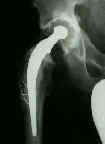
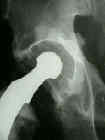
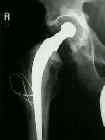
Comparison of a hybrid with an uncemented total hip replacement. A retrospective matched-pair study.
Hybrid total hip arthroplasty.
Hybrid total hip replacement. A 6.5-year follow-up study.
Charnley total hip arthroplasty with cement. Fifteen-year results.
Long-term results of cemented total hip arthroplasty.
Charnley total hip arthroplasty. A ten- to 14-year follow-up study.
Long-term follow-up of cemented total hip arthroplasty in rheumatoid arthritis.
The survival of the cemented femoral component of a total hip replacement.
Cemented total hip arthroplasty with contemporary techniques. A five-year minimum follow-up study.
The femoral component in low-friction arthroplasty after ten years.
The Clayton total hip arthroplasty. A ten-year follow-up study.
Charnley low-friction arthroplasty in the young patient.
Total hip arthroplasty with cement after renal transplantation. Long-term results.



